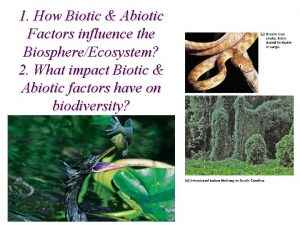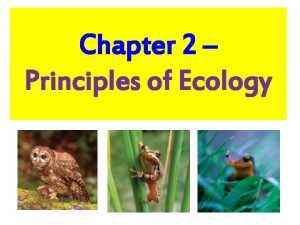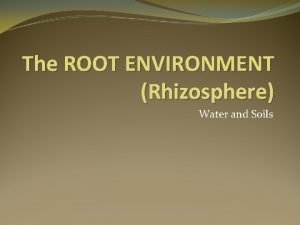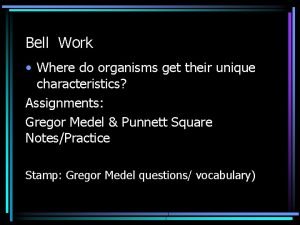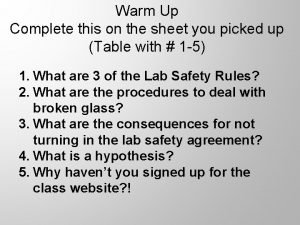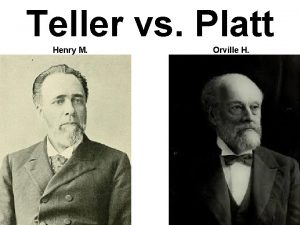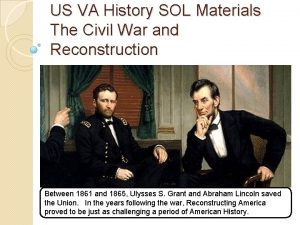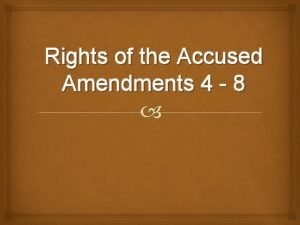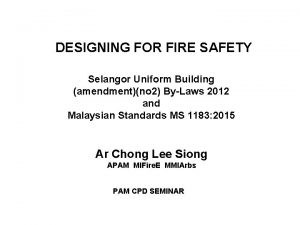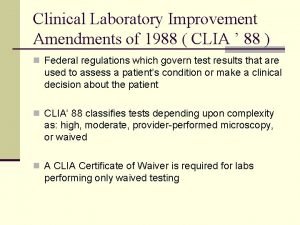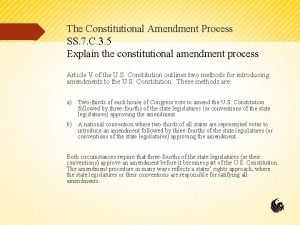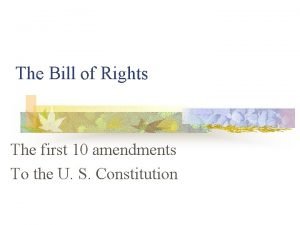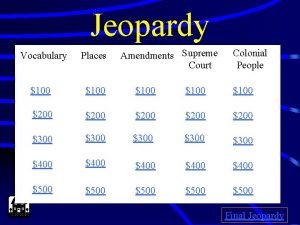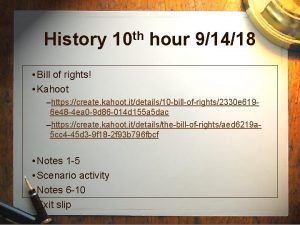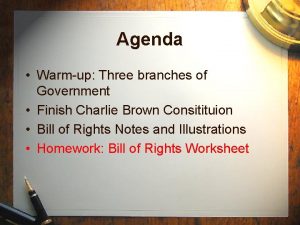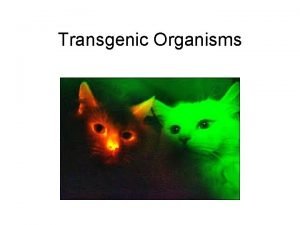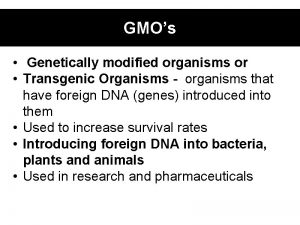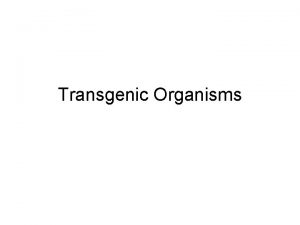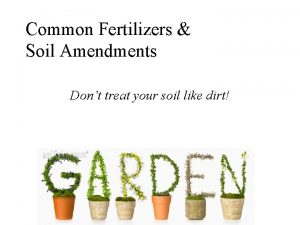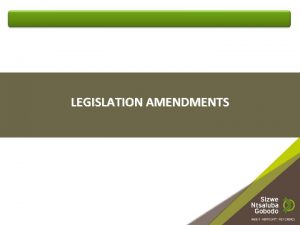Soil soil organisms soil amendments and their relation












































- Slides: 44

Soil, soil organisms, soil amendments, and their relation to plant health Thanks to Craig Cogger Extension Soil Scientist WSU-Puyallup http: //www. puyallup. wsu. edu/soilmgmt 1

Soil Components Mineral Matter Pore Space Organic Matter

The soil ecosystem Residue decomposition Nutrient cycling Aggregation and porosity Enhance plant growth Break down contaminants

• Water Movement How quickly water moves through soil Water Holding Capacity How much water a soil can hold available for plant growth

Soil pores and water movement • Macropores: Infiltration and drainage through soil • Capillary pores: Available water for plants • Micropores: Unavailable water (clay)

Soil properties that affect porosity • Soil texture • Soil structure • Compaction and disturbance • Organic matter

Hand texture technique: clay

Soil Structure Aggregation of sand, silt, and clay particles Structure affects: Macroporosity Infiltration Aeration

Formation of soil structure • Growth of roots and movement of organisms create pores and aggregates • Soil organisms break down organic residues, producing glues (glomalin) that stabilize aggregates • Beneficial fungi provide structural support to aggregates • Physical, chemical processes also involved

Effects of development on urban and suburban soils • Increased bulk density • Resistance to root penetration • Loss of structure • Reduced porosity • Reduced infiltration • Reduced rooting depth • Reduced nutrients and water availability

Prescription • Incorporate organic matter

Expected benefits of organic matter • Physical: Improved bulk density, structure, porosity, permeability, • Biological: More activity • Available water: Increase depends on soil and irrigation regime • Runoff: Better structure and porosity reduces runoff and erosion • Nutrients: Significant for some materials

Soil Organisms Bacteria, fungi, actinomycetes, protozoa, nematodes, arthropods, earthworms Pictures courtesy M. Fauci and D. Bezdicek

Roles of soil organisms Residue decomposition Nutrient cycling Aggregation and porosity Contaminant breakdown Nitrogen fixation Enhance root function Pathogen Predators Mary Fauci

Soil food web and nutrient cycling Phytophagous nematodes Roots Predacious mites Collembolans Mycorrhizae Nematode Feeding mites Cryptostigmatid mites Noncrypto. Stigmatid mites Fungi Detritus Fungivorous nematodes Predacious nematodes Omnivorous nematodes Flagellates Amoebae Bacteria Bacterivorous nematodes

Organic matter stimulates soil organisms • Formation of soil structure • Nutrient cycling • Plant disease suppression

Choosing organic amendments 17

Why use compost as a source of organic matter? • Locally produced, recycled material • Home, farm, or commercial • Can usually be applied at high rates to increase organic matter benefits • Hot composting kills pathogens

Solutions to Compacted Soil • Research-based science • Proven effective in horticultural use over many years • There are three main parts. . . 19

Research Results: Excerpts from Trees, people & the built environment: Proceedings of the Urban Trees Research Conference-April 2011 • This is not the research I mean! 20

Be careful from whom you take advice. . . • Using Soil : How to Break Up Clay Soil https: //www. youtube. com/watch? feature=player_detailpage&v=_ATp. A 3 bovg. E 21

“How to Break Up Clay Soil” § Let’s analyze Rick’s recommendations § Gypsum is often recommended for use in clay soils. § Clay in the Kansas City metro area is a species of Smectite clay called montmorillonite, a shrink/swell clay. 22

“How to Break Up Clay Soil” Montmorillonite clay 23

“How to Break Up Clay Soil” by Rick • Rick recommends 25 pounds of gypsum per 5 sq. ft. • or 5 lbs. /sq. ft. • or 5, 000 lbs. / 1, 000 sq. ft. • A catastrophic amount in soil! 24

Research Results: Excerpts from Trees, people & the built environment: Proceedings of the Urban Trees Research Conference. April 2011 • Rooting environment - mycorrhizal fungi • In one of the earliest arboricultural texts, Wm. Solotaroff (1911) urban forester, states ‘a great deal, if not all of the success in tree growing depends upon the nature and the preparation of the soil’. This observation has, over time, been proven to be true. > Since drought, use of winter de-icing salts, lack of nutrients, and attack from disease pathogens are among the main causes of failure of urban trees and lawns (Fini and Ferrini, 2007), the inoculation of urban landscapes with selected, native, competitive and effective mycorrhizal fungi may enhance tree and turf survival and growth in the urban environment. 25

• Agriculture and Natural Resources HYG-3305 -08 • • Mycorrhizae in Urban Landscapes Nathan M. Kleczewski, Dennis Lewandowski, and Pierluigi (Enrico) Bonello Department of Plant Pathology The Ohio State University • Artificial mycorrhizal inoculation may benefit plants when there is no natural and appropriate mycorrhizal inoculum in the soil, the inoculum level is low, or species present are less efficient at aiding the plant host than those being introduced. . . In principle, highly compacted, organic nutrient-poor soils in urban environments may also be prime candidates for artificial mycorrhizal inoculation. 26

Arbuscular Mycorrhizal Fungi • An arbuscule of a AM fungus. Photo by M. Brundrett (with permission). 27

Ectomycorrhizal Fungi Highly branched EM root tip. Photo by Nathan Kleczewski. 28

Rhizosphere Maintenance • The rhizosphere is the region of soil in intimate contact with the roots of a plant. The health of a rhizosphere is critical to plant performance. This area contains a complex array of plant-associated communities of microorganisms vital for soil health (Buée et al. , 2009). • While it is difficult to directly influence the actual rhizosphere, interventions to promote soil ecology and good soil structure will promote rhizosphere health and simultaneously improve plant performance. It is essential that soil health is on the agenda of those seeking to establish trees and turf in the urban environment (Buée et al. , 2009). 29

• Mycorrhizal fungi were tested on newly planted and mature linden (Tilia) trees and horse chestnut trees (Aesculus) growing in a poor, heavily compacted soil and researchers found that symbiosis was more successful on mature trees, compared to newly planted ones. • There is research evidence that soil compaction limits root growth and rhizosphere activity (Fini and Ferrini, 2007) and also reduces mycorrhizae formation (Nadian et al. , 1997; Entry et al. , 2002). ! § Conclusion • Research results obtained to date showed that the work of selecting, multiplying and inoculating woody species with site- and species-specific mycorrhizal fungi can result in greater growth and improved physiology. • That’s part one of the solution!! 30

Plant Growth Stimulators • Application of organic products, such as humates and plant extracts, at planting have shown only limited benefit to root or shoot growth of trees and turf. Species vary widely in their response (Kelting et al. , 1998 a, 1998 b; Ferrini and Nicese, 2002; Fraser and Percival 2003; Gilman, 2004; Sammons and Struve, 2004) to the applications of these materials. • Most commercial plant growth stimulators should be applied by professionals trained in the use of these materials. 31

Plant Growth Stimulators • Paclobutrazol, a growth regulator used primarily to reduce leaf growth on trees and turf, can also stimulate rapid root growth under certain circumstances. • Paclobutrazol applied at planting doubled root growth on black maple (Acernigrum) in the first season, but not the second. The lack of root response in the second season is thought to be related to roots being restricted by water deficit, high salt content of the soil, and reaching planting hole boundaries of compacted soil that roots could not penetrate. • That’s part two of the solution!! 32

Soil Decompaction! • The bulk density of soil is demonstrated to be limiting to tree growth and turf development; decompaction of the rooting environment has considerable value regardless of landscape age. • While a variety of approaches are available to ‘decompact’ soil, the value of some equipment has been questioned. It is now clear that only those approaches which result in a significant and widespread reduction in soil bulk density throughout the rooting volume have appreciable merit. (Smiley et al. , 1990; Smiley, 1994; Hascher and Wells, 2007). • • High pressure pneumatic soil excavation tools (e. g. Air Spade®, Supersonic Air Knife, Soil Pick©) have been demonstrated to achieve this and are capable of cultivating the soil to a depth of 10 - 12 inches (25– 30 cm) using compressed air to excavate soil with minimal disturbance or damage to tree roots (Felix, 2004). 33

Trees, people and the built environment! Proceedings of the Urban Trees Research Conference April 2011 • RESEARCHERS found this approach to be particularly valuable when combined with a nutritional amendment in a technique known as Root Invigoration. Since there is so little damage, larger areas can be excavated, which greatly expands the available area for root growth and development (Smiley, 1999). • • Root Invigoration http: //www. bartlett. com/root-rx-vid-lg. cfm? rs • That’s part three of the solution!! 34

Soil Renovation Take Aways • • Thanks to Dr. Kim Coder, University of Georgia Gardeners must correct compaction and its limitations on plant growth. Compaction must be prevented and actively corrected. Here are some renovation principles derived from research activities to consider. • Principle 1 -- Soils do not “come back” from compaction. Soil must be actively renovated. • Principle 2 -- A garden is a composite of many compaction events over many years, all needing remediation. • Principle 3 -- Management activities should concentrate on increasing aeration space and reducing soil strength, rather than trying to recover past ecological history by topically adding amendments. • Principle 4 -- Estimate soil compaction now as a bench-mark for gauging effectiveness of any treatment. 35

Soil Renovation Take Aways Principle 5 -- Measure compaction using any or all approximations, such as bulk density, penetration force, oxygen diffusion rates, and plant available water. (Laboratory analysis) Principle 6 -- Alleviation of soil compaction is part of a good garden soil health management plan. 36

Once the general principles of working with compacted soils are digested, the next requirement in garden soil health care is to identify general techniques for renovating compacted soils. • The two main objectives are: 1) remove enough soil volume from compacted soil to make a significant difference in soil bulk density and fracture hardpan layers; or 2) pierce the soil enough to significantly impact gas exchange with the atmosphere. 37

• Soil Renovation Techniques Thanks to Dr. Kim Coder, University of Georgia Technique 1 -- Defend the ecological “foot print” of a garden rooting area. Select working conditions (dry, dormant season, surface mulch, etc. ) that minimize compaction in a rooting area. Technique 2 -- Carefully design garden growth areas using “biologyfirst” design processes rather than the common (and damaging) “aesthetics-first” design processes. Technique 3 -- Try to soften and distribute any new compaction forces applied to garden soil by using temporary coarse, thick organic mulch, plywood, or rubber planting pads. 38

Soil Renovation Techniques Technique 4 -- Restart or improve the detritus energy web in soil, including the addition of composted organic matter, living organisms, essential nutrients in short supply, and water (supply & drainage). Technique 5 -- If tree roots are not present on-site, use deep tilling to fracture and aerate soil before other activities are begun for installing garden plants. Technique 6 -- Utilize porous paving materials, soil binding materials, or root aggregation structures, where possible, to avoid further compaction. 39

Soil Renovation Techniques Technique 7 -- Use core (not punch) aerators designed for compacted areas which reach 8 -14 inches in depth. These are large hydraulic powered core aerators, not shallow surface aerators as used in turf culture. Technique 8 -- A derivation of core aerators is the use of compressed air probes. High pressure air is used to fracture soil. Materials added could be either liquid or granular, and include fertilizers, organic matter, biologics, and porous solids for holding soil fractures apart. Technique 9 -- Use soft excavation techniques like air guns to cultivate (stir-up) soil in selected areas under trees (Bartlett renovation technique). Composted organic matter and other soil and growth materials can be incorporated during this operation. 40

Soil Renovation Techniques Arboriculture & Urban Forestry 37(6): November 2011 Evaluation of a Soil Decompaction and Amendment Process for Urban Trees Kelby Fite, E. Thomas Smiley, John Mc. Intyre, and Christina E. Wells Abstract. Researchers investigated the effects of a soil decompaction and amendment process (AFM) and its individual components (air tillage, fertilizer, and mulch) on soil properties at four urban sites. At each site, 50 red maples (Acer rubrum) were growing on compacted and/or nutrientpoor soils. The AFM treatment significantly reduced soil strength relative to control at all sites. . . Overall, AFM was effective in improving soils beneath established trees, and mulching was the most beneficial of the individual treatments. 41

Soil Renovation Techniques Arboriculture & Urban Forestry 37(6): November 2011 Evaluation of a Soil Decompaction and Amendment Process for Urban Trees Kelby Fite, E. Thomas Smiley, John Mc. Intyre, and Christina E. Wells CONCLUSIONS A program of air tillage, prescription fertilization, and mulch improved a suite of physical and chemical properties in urban soils. . In the field, practitioners should experiment with specific materials, techniques, and treatment frequencies to best address the needs of individual sites. Nonetheless, it is clear that a multi-pronged approach to soil remediation gives arborists an effective means to improve compacted soils beneath established urban trees. 42

J. Paul Getty Museum Garden - Malibu, California 43

Contact Information Bill Nolde, MS Consulting Arborist member, American Society of Consulting Arborists ISA Certified Arborist, Cert. #MW 5326 -A member, International Society of Arboriculture Consulting Agronomist member, American Society of Agronomy Consulting Soil Scientist member, Soil Science Society of America Nolde and Associates Direct: 816 -820 -3262 Email: nolde. arborist@gmail. com Website: www. treecaretoday. info 44
 Unicellular vs multicellular organisms
Unicellular vs multicellular organisms Why do organisms interact with other organisms
Why do organisms interact with other organisms Principles of ecology section 3 cycling of matter
Principles of ecology section 3 cycling of matter Section 1 organisms and their relationships
Section 1 organisms and their relationships Chapter 2 section 1 organisms and their relationships
Chapter 2 section 1 organisms and their relationships Chapter 2 principles of ecology
Chapter 2 principles of ecology Chapter 2 principles of ecology answer key
Chapter 2 principles of ecology answer key Living organisms and their surroundings
Living organisms and their surroundings Chapter 2 section 1 organisms and their relationships
Chapter 2 section 1 organisms and their relationships Soil organisms
Soil organisms Where do organisms get their traits?
Where do organisms get their traits? Where do all organisms get their energy
Where do all organisms get their energy The process of grouping things based on their similarities.
The process of grouping things based on their similarities. Organisms that make their own food
Organisms that make their own food Platt amendment vs teller amendment
Platt amendment vs teller amendment Formal vs informal amendments
Formal vs informal amendments The fifth, sixth, seventh, and eighth amendments protect *
The fifth, sixth, seventh, and eighth amendments protect * Reconstruction amendments
Reconstruction amendments Title xi of the education amendments of 1972
Title xi of the education amendments of 1972 1-10 amendments
1-10 amendments First 10 amendments
First 10 amendments First 10 amendments
First 10 amendments Warren court apush
Warren court apush Rights of the accused amendments 4-8
Rights of the accused amendments 4-8 Amendment mun
Amendment mun Bill of rights amendments 11 27
Bill of rights amendments 11 27 Basic legislation informal amendments examples
Basic legislation informal amendments examples What are the amendments 1-10
What are the amendments 1-10 Amendments 11 27
Amendments 11 27 What are the amendments 1-10
What are the amendments 1-10 Title ix of the education amendments of 1972
Title ix of the education amendments of 1972 Dead end limit ubbl
Dead end limit ubbl Define citizen rights
Define citizen rights 10 amendments bill of rights
10 amendments bill of rights 10 amendments bill of rights
10 amendments bill of rights Clinical laboratory improvement amendments of 1988
Clinical laboratory improvement amendments of 1988 All the amendments
All the amendments Right to bear arms
Right to bear arms Bill of rights 10 amendments
Bill of rights 10 amendments Bill of rights 10 amendments
Bill of rights 10 amendments Amendments
Amendments Bill of rights 10 amendments
Bill of rights 10 amendments Bill of rights 10 amendments
Bill of rights 10 amendments Ten amendments
Ten amendments Section 1 the six basic principles
Section 1 the six basic principles







